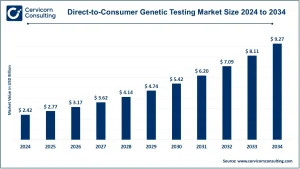Market Overview
The global blockchain-based electronic health record market is expanding rapidly, driven by the increasing demand for secure, interoperable, and patient-controlled healthcare data solutions. In 2024, the market was valued at USD 1.06 billion and is forecast to reach nearly USD 14.85 billion by 2034, registering a compound annual growth rate (CAGR) of about 30.2% during 2025–2034.
In terms of regional distribution, North America held approximately 36% of the market share in 2024, followed by Europe at 29%. By component, software accounted for nearly 47%, while on-premises deployment represented around 52% of total adoption. Among end users, hospitals and clinics currently dominate, though the patient segment is projected to witness the fastest growth in the coming years.
Get a Free Sample: https://www.cervicornconsulting.com/sample/2630
Key Market Trends
1. Government and Health System Adoption
Governments and public health systems are increasingly integrating blockchain to enhance data security and interoperability. Countries such as Estonia, the UAE, and Sweden are already implementing blockchain-based national health record systems—transitioning from pilot programs to full-scale deployments. This reflects growing institutional confidence in blockchain’s ability to protect patient data and ensure transparency.
2. Shift Toward Patient-Centric Data Control
Patients are gaining greater authority over their medical information, emphasizing consent-based access and data ownership. Blockchain enables individuals to manage their own health records—granting, tracking, and revoking access in real time. This shift toward decentralized, patient-managed systems is accelerating growth in the patient end-user category.
3. Integration with Digital Health and IoMT
The rise of telemedicine, mobile health applications, and the Internet of Medical Things (IoMT) has led to massive data generation that requires secure sharing. Blockchain technology ensures the authenticity, privacy, and interoperability of this data, positioning itself as a key enabler of the connected digital health ecosystem.
4. Strengthened Data Security and Regulatory Compliance
Amid escalating cyber threats and stricter data protection laws such as HIPAA and GDPR, healthcare providers are prioritizing robust security frameworks. Blockchain’s tamper-proof and decentralized architecture provides an ideal solution for ensuring regulatory compliance, data integrity, and protection against breaches.
5. Transition Toward Hybrid and Cloud Models
While on-premises deployment remains prevalent, cloud and hybrid blockchain solutions are gaining momentum for their scalability and cost advantages. These models allow distributed healthcare systems to securely store and access medical data while optimizing operational efficiency.
Market Drivers
-
Rising demand for secure and interoperable data systems: Traditional EHRs suffer from data silos and security risks. Blockchain’s decentralized and transparent structure resolves these issues by ensuring immutable data exchange.
-
Expansion of digital health technologies: The growing use of telehealth, wearables, and remote monitoring tools drives the need for real-time, secure data transmission—an area where blockchain delivers clear benefits.
-
Increasing focus on cybersecurity and compliance: Frequent data breaches and privacy mandates are compelling healthcare institutions to invest in blockchain-based solutions.
-
Government and institutional initiatives: National health authorities and large hospital networks are increasingly embedding blockchain into digital health infrastructure to streamline data governance.
-
Rising patient empowerment: Growing awareness and demand for transparent, self-managed health data systems are driving adoption of patient-centered blockchain platforms.
Quantitatively, the market’s rise from USD 1.06 billion in 2024 to USD 14.85 billion by 2034, at a 30.2% CAGR, demonstrates the strong momentum and confidence in blockchain’s healthcare applications.
Impact of Trends and Drivers
Regional Landscape
-
North America leads due to strong healthcare IT infrastructure, early blockchain adoption, and favorable policies.
-
Europe is advancing under stringent data protection laws and public-sector funding initiatives.
-
Asia-Pacific is the fastest-growing region, supported by healthcare digitalization, infrastructure expansion, and technology investments.
End-User Analysis
-
Hospitals and clinics dominate usage given high data volumes and compliance requirements.
-
Patients are emerging as the most dynamic segment as personal health management and remote data access become mainstream.
Component and Deployment
-
Software solutions currently account for the largest share.
-
Hybrid and cloud deployments are expected to grow quickly, offering greater flexibility, scalability, and lower maintenance costs.
Applications
Beyond managing patient records, blockchain is increasingly being applied to medical billing, insurance claims, clinical trials, and pharmaceutical supply chain management, creating a broad ecosystem of use cases.
Challenges and Opportunities
Challenges:
-
High setup and integration expenses for blockchain infrastructure
-
Lack of standardized data frameworks and interoperability protocols
-
Regulatory ambiguity and evolving compliance landscapes
-
Institutional resistance to replacing legacy EHR systems
Opportunities:
-
Expanding adoption in emerging regions, particularly Asia-Pacific and the Middle East
-
Development of patient-centric and mobile-first blockchain applications
-
Integration with IoMT, AI, and analytics for predictive and precision healthcare
-
Increasing public-private partnerships and strategic collaborations between technology vendors, hospitals, and governments
Future Outlook
The blockchain-based electronic health record market is poised for exponential growth, evolving from a niche innovation into a core component of global healthcare infrastructure. With a projected CAGR of 30.2% through 2034, the market will be shaped by several key developments:
-
Broader migration to cloud and hybrid blockchain models
-
Seamless interoperability among EHRs, telemedicine platforms, and wearable devices
-
Greater patient empowerment through decentralized data control
-
Stronger regulatory alignment promoting secure cross-border data exchange
In summary, blockchain is revolutionizing healthcare data management by introducing unprecedented levels of trust, security, and efficiency. As digital transformation accelerates across the healthcare sector, blockchain-based EHR systems are set to become the backbone of next-generation health ecosystems.
For detailed insights and forecasts, visit Cervicorn Consulting.
